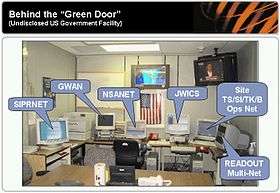Classified United States website
A variety of networks operating in special security domains handle classified information in the United States or sensitive but unclassified information, while other specialized networks are reserved specifically for unclassified use by the same agencies. Some sites accessed from these networks have been referred to as "classified websites" in official communications, such as the American embassy "Amman's Classified Web Site at http://www.state.sgov.gov/pinea/amman/"[1] and "Mexico City's Classified Web Site at http://www.state.sgov.gov/p/wha/mexicocity" [2] Some of these trace back to the Defense Data Network which split from the Internet in 1983.
Networks
NIPRNet
NIPRNet is a low-security network reserved for unclassified information, such as regular Internet websites and firewalled but unclassified military websites.[3]
OpenNet
According to the U.S. Department of State Foreign Affairs Manual, "OpenNet is a physical and logical Internet Protocol (IP)-based global network that links the Department of State's Local Area Networks (LANs) domestically and abroad. The physical aspect of the network uses DTS circuits for posts abroad, FTS-2001-provided circuits, leased lines, and dial-up public switch networks. This includes interconnected hubs, routers, bridges, switches, and cables. The logical aspect of the network uses Integrated Enterprise Management System (NMS) and TCP/IP software, and other operational network applications. OpenNet is a Sensitive But Unclassified (SBU) network, which supports e-mail and data applications."[4]
OpenNet+
OpenNet+ is described for State Department use as using standard .state.gov domain names, which must be requested through a State Department intranet site at http://intranet.state.gov/ds3081 . Web site development cannot be done on machines directly connected to this network. The "www" prefix is not to be used on OpenNet+, as it is reserved for use on the Internet.[5]
DNI-U (OSIS)
OSIS was the name of an "unclassified network serving the intelligence community with open-source intelligence". Originally used to refer both to the network and to the content it provided, it has since been decoupled, with the content named "Intelink-U", while the network continues as DNI-U. The network is maintained by the DNI-CIO Intelligence Community Enterprise Services office (ICES).[6][7][8]
ClassNet
ClassNet domain names for the State Department take the form ".state.sgov.gov". Web pages for ClassNet may be developed on a "classified workstation". "Any workstation used for development purposes may not serve as the operational repository of images, files, or other information associated with a Web site."[5] ClassNet is used for telecommunications, and its use is promoted by the Business Center Division.[4] Two versions of the State Messaging and Archival Retrieval Toolset (SMART) database were created, one with a maximum rating of Sensitive but Unclassified (SBU) for OpenNet+, and one with a top rating of Secret for ClassNet.[9]
SIPRNet (DSNET1)
SIPRNet is a medium-security network for handling information classified Secret or below. It may be used to access classified websites run by the Defense Intelligence Agency.[3] SIPRNet replaced the Defense Data Network DSNET1 component.[10]
NSANet
NSANet handles information rated Top Secret or Sensitive Compartmented Information.[3]
JWICS
The Joint Worldwide Intelligence Communications System (JWICS) is a secure TCP/IP network providing services such as hypertext and e-mail rated up to Top Secret and SCI. JWICS replaced the Defense Data Network DSNET2 (Top Secret) and DSNET3 (SCI) networks.[3][11][12]
Note
SI = Special / Secret Intelligence TK is a codeword classification, standing for Talent Keyhole, meaning IMINT. TS/SI/TK is often used as a blanket "entry level clearance" for conferences, etc., as it is one of the most carefully controlled and restricted. B = BYEMAN (National Reconnaissance Office)
References
- "ALLEGATIONS THAT GOJ TORTURES, AND RUNS SECRET PRISONS WITH U.S." (PDF). U.S. Department of State. Archived from the original (PDF) on 2009-07-15.
- "Viewing cable 09MEXICO3573, MEXICAN NAVY OPERATION NETS DRUG KINGPIN ARTURO". Wikileaks. 2010-12-02. Archived from the original on 2010-12-06. Retrieved 2010-12-03.
- Sharon Weinberger (2010-12-01). "What Is SIPRNet?". Archived from the original on 2010-12-05. Retrieved 2010-12-03.
- "1 FAM 270 BUREAU OF INFORMATION RESOURCE MANAGEMENT (IRM)". U.S. Department of State Foreign Affairs Manual. Retrieved 2015-12-13.
- "U.S. Department of State Foreign Affairs Handbook Volume 5 Handbook 8". U.S. Department of State. 2005-05-29.
- "Open Source Information System (OSIS)". Federation of American Scientists.
- Noel Brinkerhoff (2009-06-04). "8 Extremely Little-Known Corners of the U.S. Intelligence Network…and 4 More". Allgov.
- "National Intelligence: A Consumer's Guide" (PDF). U.S. Director of National Intelligence (free download). Archived from the original (PDF) on 2012-05-24.
- "Advisory Committee on Historical Diplomatic Documentation minutes". Federation of American Scientists. 2003-09-16.
- "Secret Internet Protocol Router Network (SIPRNET)". Federation of American Scientists.
- "Archived copy". Archived from the original on 2011-02-20. Retrieved 2010-12-03.CS1 maint: archived copy as title (link)
- https://fas.org/irp/program/disseminate/jwics.htm
